Add a website url to get relevant backlinks and their DR

Backlinks are one of the most powerful factors that influence a website’s ranking in search engine results. But managing and tracking these links can be challenging without the right tools. A free backlink checker helps you monitor who’s linking to your site, assess the quality of those links, and even spy on your competitors’ backlink profiles. Whether you’re looking to improve your SEO, build stronger link-building strategies, or simply understand your site’s current performance, using a backlink checker can provide you with crucial insights—all without spending a dime.
Backlinks are a foundational element of SEO because they influence how search engines evaluate and rank your website. Essentially, a backlink is seen as a vote of confidence from one site to another. The more quality backlinks you have, the more trustworthy your site appears to search engines like Google. However, not all backlinks carry the same weight. Factors like the authority of the linking site, the relevance of the content, and the type of link all contribute to its impact on SEO. Here’s why backlinks matter:
Websites with more high-quality backlinks tend to rank higher in search engine results, helping you attract more organic traffic.
Search engines like Google use backlinks as a measure of a site’s authority. A well-established site linking to yours can significantly boost your domain authority.
Besides improving SEO, backlinks can also generate referral traffic. Visitors who click on your backlinks are likely interested in your content or services.
A backlink from a reputable site signals that your content is trustworthy and worth referencing, which builds credibility.
Websites with more high-quality backlinks tend to rank higher in search engine results, helping you attract more organic traffic.
Backlinks, often referred to as inbound links or external links, are hyperlinks from one website to another. When a website links to your site, it’s essentially vouching for your content, which can positively influence your SEO. Search engines like Google use backlinks as an indicator of the relevance and authority of a webpage. The more high-quality sites that link to your content, the more likely search engines are to view your site as trustworthy.
For example, if a well-known news outlet like The New York Times links to an article on your site, that backlink is seen as a strong endorsement. This not only signals to Google that your content is reliable, but it can also drive referral traffic directly from The New York Times to your site. On the other hand, a backlink from an irrelevant or low-quality site won’t have the same positive impact, and in some cases, it could even hurt your rankings.
Understanding the value of backlinks is key to improving your SEO, and that’s why monitoring your backlink profile with tools like a free backlink checker is so important.
Not all backlinks are created equal, and understanding the different types can help you better manage your SEO strategy. The type of backlink can affect how search engines interpret it, and knowing this will guide your link-building efforts. Here are the main types of backlinks:
These are the most valuable type of backlink because they pass SEO value (or "link juice") from the linking site to your site.
For example, if a high-authority website includes a dofollow link to your content, it can improve your search rankings significantly.
These links include a tag that tells search engines not to pass SEO value to the linked site. Nofollow backlinks are still useful for driving traffic, but they don’t directly impact your SEO.
For example, links in blog comments or forum posts are often nofollow.
These are links that are paid for or part of a sponsorship deal. Google requires these links to be tagged as "sponsored" to ensure transparency and avoid manipulation of search rankings.
An example might be a link to your site included as part of a paid advertising campaign on a blog.
Links found in user-generated content, such as comments or forum posts, are classified as UGC.
These links are usually nofollow, but they can still bring traffic if placed on a popular or relevant platform.
Competitors App is a powerful tool that not only allows you to monitor your own backlinks but also lets you analyze your competitors’ backlink profiles. This can be invaluable for understanding your SEO performance and discovering new opportunities for link building. Here’s how you can use Competitors App to check backlinks:
Monitor Your Backlinks: Competitors App provides a clear overview of the backlinks pointing to your site. You can track new backlinks as they appear and identify any lost links over time. This helps ensure that your link-building efforts are paying off and that no important links have disappeared unexpectedly.
Analyze Link Quality: Not all backlinks are beneficial, and Competitors App allows you to assess the quality of your links. You can check metrics like the authority of the linking domain to ensure that the backlinks you’ve earned are from trustworthy and relevant sites.
Track Competitor Backlinks: One of the standout features of Competitors App is the ability to monitor your competitors’ backlink profiles. You can see where their links are coming from, which can help you find new sites to target for your own link-building efforts.
Get Alerts for New and Lost Backlinks: Competitors App offers notifications when new backlinks are gained or when existing ones are lost. This lets you react quickly to any changes, whether it’s celebrating a win or troubleshooting the loss of an important link.
Competitors App makes it easy to keep tabs on your backlink profile and that of your competitors, giving you a competitive edge without the need for expensive tools.
First, create an account on Competitors.app. You’ll need to provide some basic information about your business and your competitors. The setup process is straightforward and user-friendly.
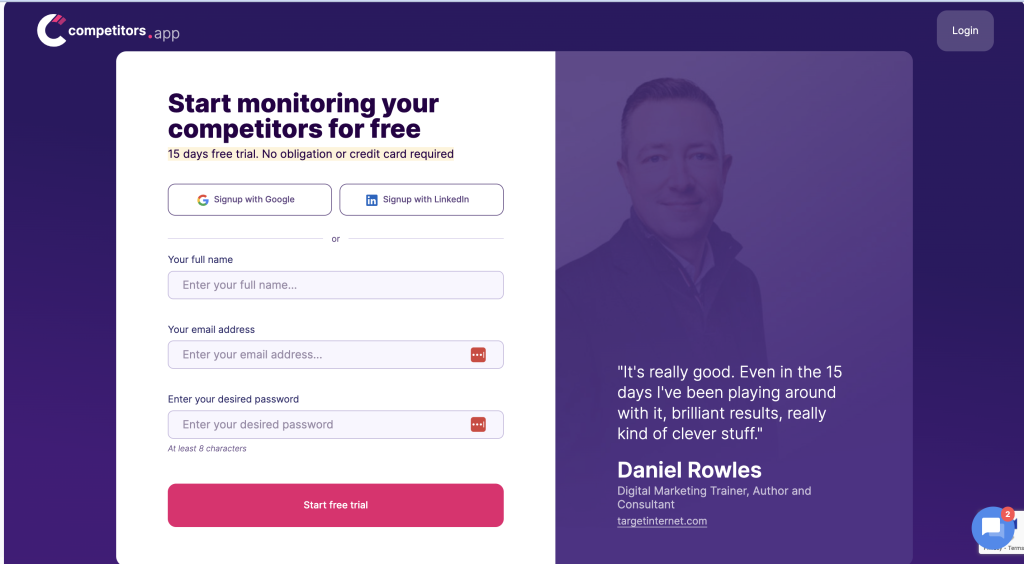
Once your account is set up, add the competitors you want to analyze. You can usually do this by entering their website URLs. Competitors.app allows you to track multiple competitors, giving you a comprehensive view of your competitive landscape.
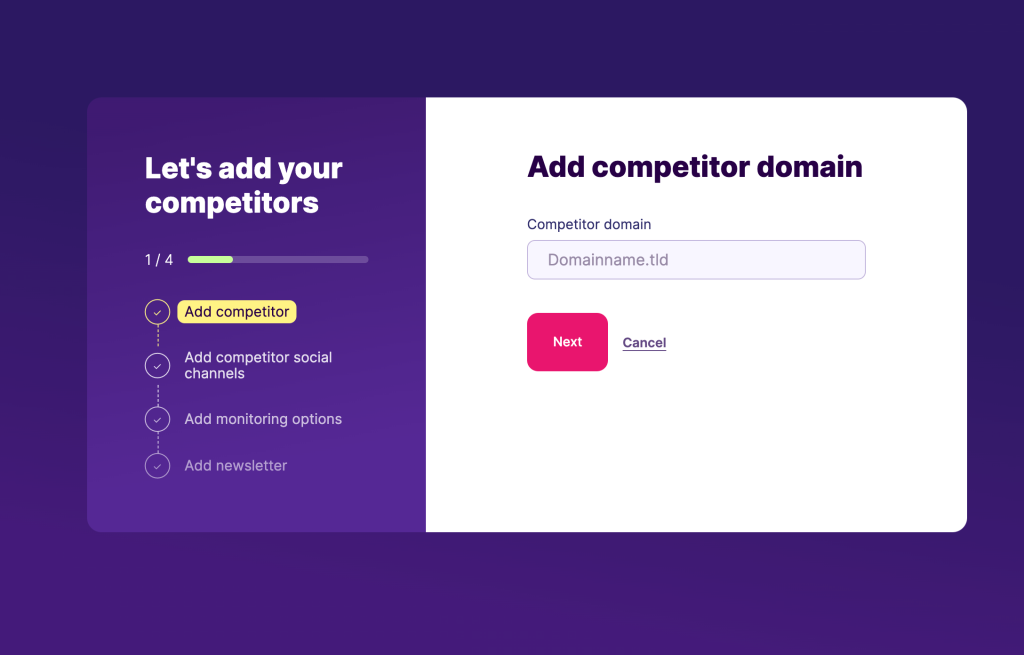
On the left-hand sidebar, click on the Backlinks tab. This will take you to a page where you’ll find everything about your competitors’ backlinks.
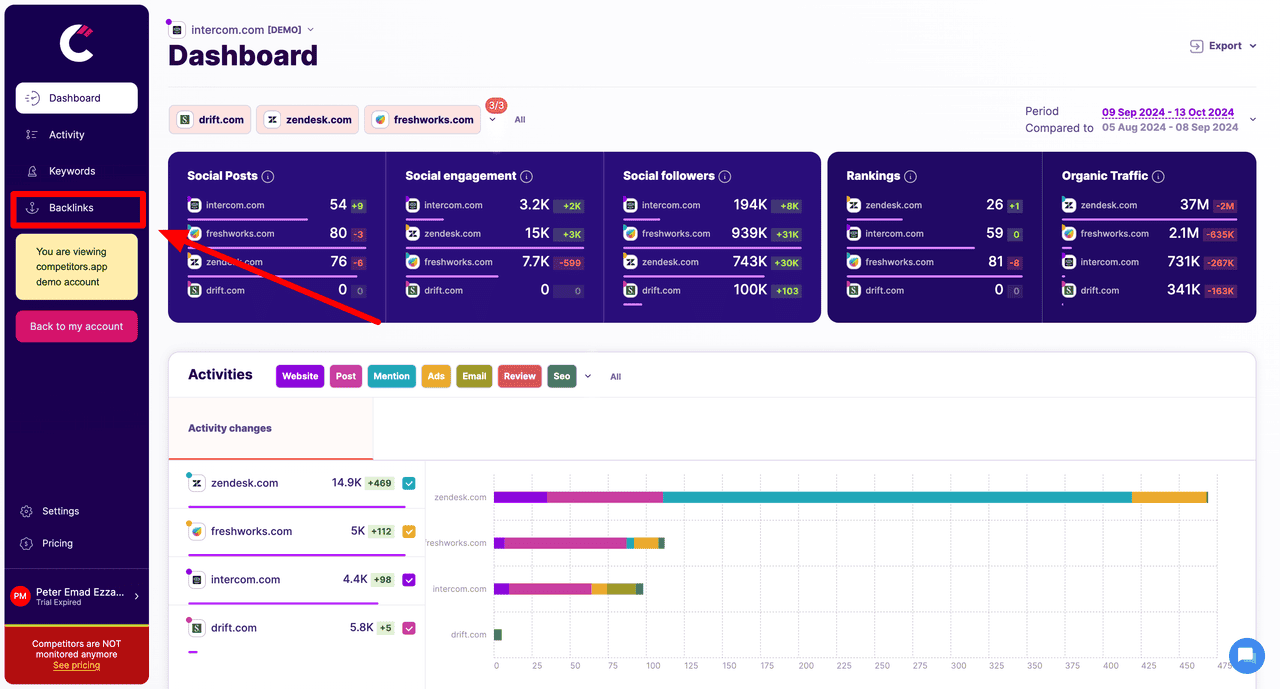
In the backlinks overview page, you’ll see a list of your competitors with their unique referring domains, page authority, domain authority and even the amount of .EDU and .GOV referring domains.
Then, you can click on any competitor to further analyze their backlink profile.
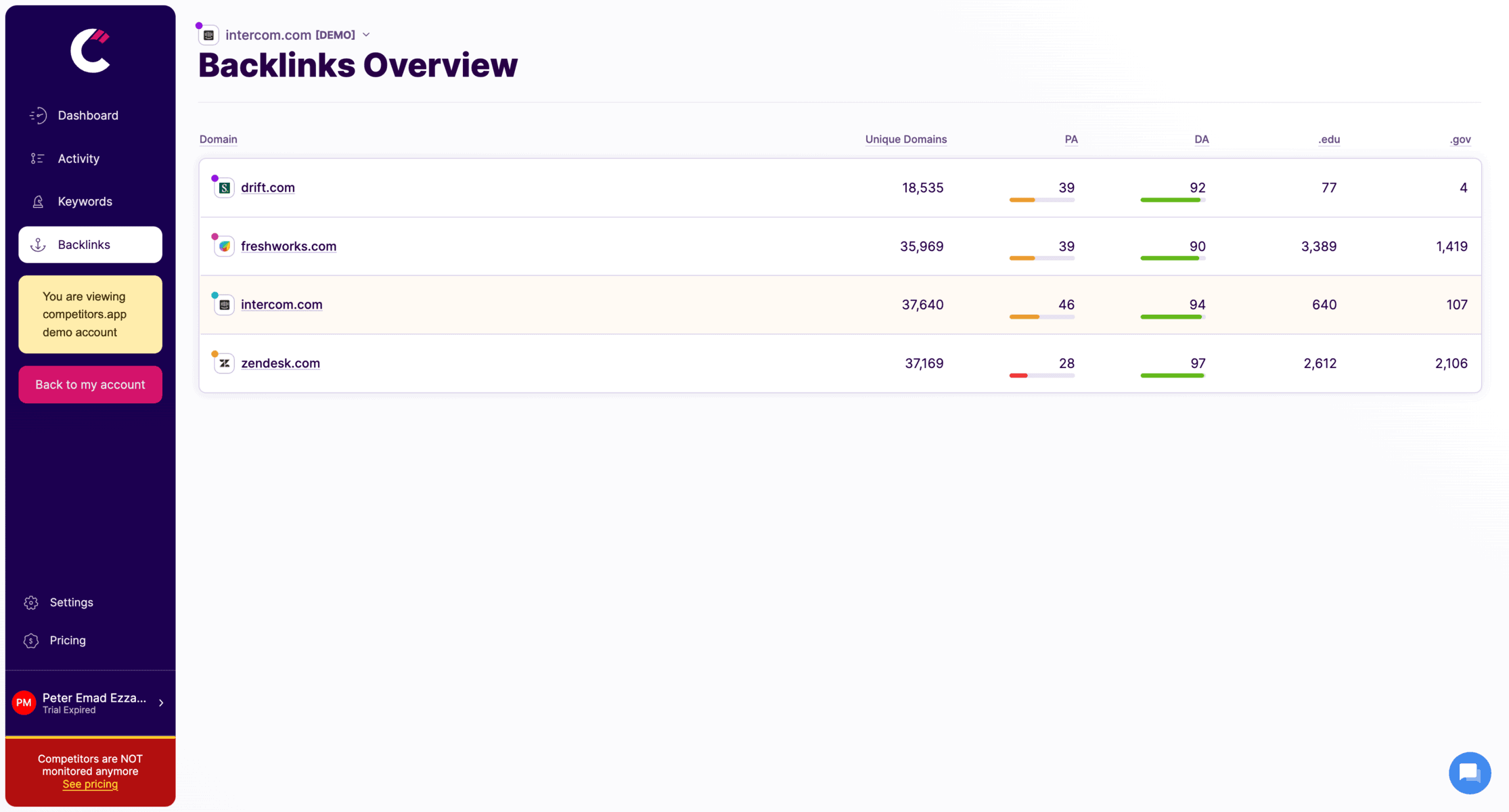
After you click on any of your competitors you’ll see all of their backlinks, the date the backlink was discovered on, whether the backlink is do follow or no follow, the anchor text, the exact page linking to them, page authority and domain authority.
From the bar at the top you can filter by competitors or select “ALL” if you want to see all of their backlinks at once.
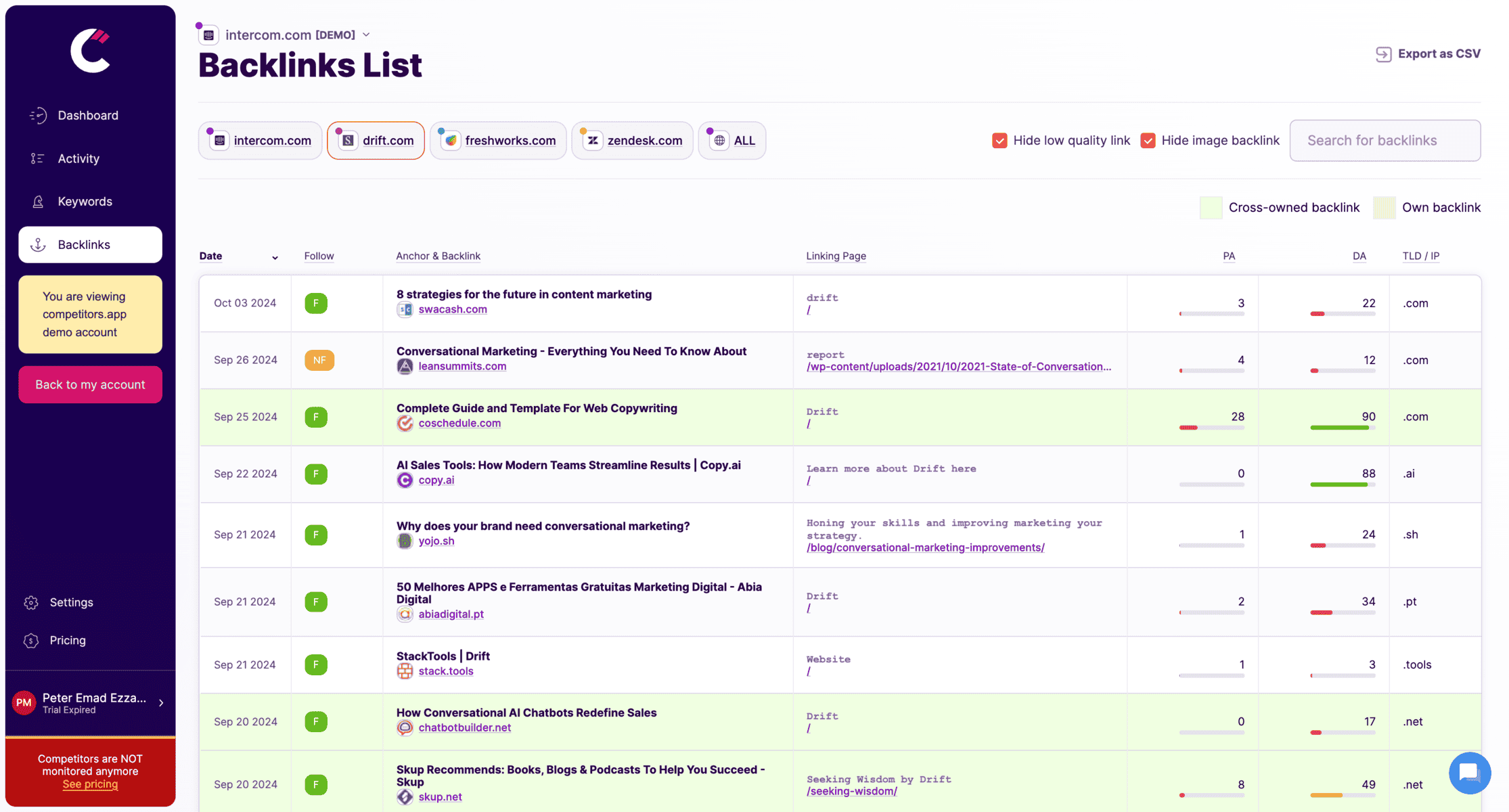
Once you have found which backlinks you want to export, you can now export the backlinks of your competitors. Before you do make sure to use the filters to excluded any unwanted backlinks like low quality backlinks or owned backlinks.

By following these simple steps, you’ll be able to track and analyze your competitors’ backlinks using Competitors App.
Analyzing backlinks is crucial for maintaining and improving a site’s SEO performance. Competitors App provides a site-wide analysis that gives you an in-depth understanding of a backlink profile, allowing you to evaluate both the quality and the relevance of your links. Here’s how Competitors App helps you analyze your backlinks:
Competitors App offers detailed insights into your backlinks, helping you stay on top of your SEO strategy:
Not all backlinks are equally valuable when it comes to SEO. Some can significantly boost your rankings, while others might have little to no impact—or worse, harm your site. Understanding what makes a backlink “good” is crucial for developing a strong link-building strategy. A good backlink is characterized by several key factors, including the authority of the linking site, the relevance of the link, and proper use of anchor text.
The authority of the site linking to yours plays a major role in determining the value of the backlink. Websites with high domain authority (DA) pass more SEO value (or “link juice”) to your site compared to those with low authority. For example, a backlink from an authoritative site like BBC or Wikipedia will have a greater positive impact on your rankings than a link from an unknown or spammy site.
High-authority sites are trusted by search engines, so a link from them boosts your credibility and ranking potential.
Low-authority sites may provide some value, but too many links from these can dilute the strength of your backlink profile.
Relevance is another critical factor that determines the quality of a backlink. If the content of the site linking to yours is closely related to your content, the backlink will carry more weight. For example, if you run a tech blog and a reputable tech site links to one of your articles, that’s highly relevant and beneficial. On the other hand, a backlink from an unrelated niche—like a fashion blog linking to your tech content—may not offer the same value.
Relevant links are more likely to boost rankings because they signal to search engines that your content is useful within its niche.
Irrelevant links can look unnatural and might not contribute as much to your SEO, even if they come from high-authority sites.
Where and how a link is placed on a page can also influence its SEO value. Backlinks placed within the main body of content (contextual links) are more valuable than those placed in footers or sidebars. Search engines view in-content links as more natural and relevant to the context of the topic.
Contextual links: These are embedded within the text of the content and provide more SEO value as they are perceived as more organic and relevant.
Footer or sidebar links: While still useful, these links carry less weight as they are often seen as less relevant to the page’s main content.
Anchor text—the clickable text that contains the hyperlink—is also crucial. A well-optimized anchor text helps search engines understand what the linked page is about.
Natural vs. Unnatural Links: Natural links use anchor text that fits naturally within the content, while unnatural links are overly optimized with exact-match keywords, which can trigger search engine penalties.
Anchor Text Influence: Descriptive and varied anchor text (e.g., “SEO strategies” instead of “click here”) can improve how search engines rank your page for relevant keywords.
Improving your backlink profile is one of the most effective ways to boost your website’s SEO. A strong backlink profile consists of high-quality, relevant links from authoritative websites, which can help increase your site’s visibility in search engines. While building backlinks takes time and strategy, there are several ways to enhance your backlink profile to ensure it benefits your SEO efforts.
Building high-quality backlinks should always be a priority over simply increasing the number of links. Here’s how you can focus on acquiring valuable backlinks:
The Do’s of Link Building
Focus on Quality Over Quantity
Aim for backlinks from authoritative, relevant sites rather than accumulating as many links as possible. A few high-quality links are more impactful than dozens of low-quality ones.
Build Relationships
Networking within your industry helps foster natural backlink opportunities. Collaborating with influencers, bloggers, and other websites in your niche can lead to valuable backlinks.
Diversify Anchor Text
Ensure that the anchor text used in your backlinks varies and looks natural. Use a mix of branded terms, keywords, and generic phrases to avoid over-optimization.
The Don’ts of Link Building
Avoid Link Schemes
Buying links, excessive link exchanges, or participating in link farms can result in severe penalties from search engines. Stay clear of any strategies that violate search engine guidelines.
Don’t Focus Solely on Dofollow Links
While dofollow links are important for SEO, a natural backlink profile includes a mix of dofollow and nofollow links. Nofollow links can still bring referral traffic and build credibility.
Ignore Low-Quality Links
Don’t pursue backlinks from sites that are irrelevant, spammy, or have low domain authority, as these can harm your SEO more than they help.
Competitors App can help you find new link-building opportunities by analyzing your competitors’ backlinks. Here’s how you can use it to improve your own profile:
| Comparison | Free Backlink Checkers | Paid Backlink Checkers |
|---|---|---|
| Cost | Free, making them accessible for small businesses or personal websites with limited budgets. | Paid, typically requiring a subscription or one-time payment, often suitable for businesses with a dedicated SEO budget. |
| Data Access | Provides basic backlink data (total backlinks, referring domains, anchor text). | Offers comprehensive data, including full backlink profiles, detailed historical data, and deeper competitor analysis. |
| Ease of Use | User-friendly, often with simple interfaces, suitable for beginners. | May have more complex features but offer advanced tools for in-depth analysis. |
| Features | Limited features: basic insights, light competitor tracking, simple reports. | Advanced features: detailed competitor analysis, historical data, integration with other SEO tools, and in-depth reporting. |
| Update Frequency | Updates less frequently, which might lead to missing new or removed backlinks. | More frequent updates to ensure accurate and up-to-date backlink data. |
| Competitor Tracking | Allows basic competitor backlink tracking. | Provides advanced competitor backlink insights and a broader analysis of competitor strategies. |
| Reporting | Limited or no in-depth reporting, making it harder to track long-term progress or present data professionally. | Offers comprehensive reporting features, useful for tracking progress and presenting professional insights. |
| Best For | Beginners, small businesses, or personal websites needing light monitoring. | Businesses and SEO professionals requiring detailed analysis, actionable insights, and long-term backlink management. |
You can check your website’s backlinks for free using tools like Competitors App and Google Search Console. Competitors App offers a free trial that allows you to analyze your backlink profile and track both new and lost backlinks. Google Search Console, on the other hand, provides basic backlink data, showing which sites are linking to yours and how frequently. Both tools are easy to use and provide essential insights into your backlink strategy without the need for a paid subscription.
It’s recommended to check your backlinks at least once a month to ensure you're maintaining a healthy backlink profile. Frequent monitoring allows you to spot new opportunities, identify toxic or low-quality links, and track the progress of your link-building campaigns. If you’re actively engaged in a link-building strategy, more frequent checks—such as weekly—may be beneficial.
A good backlink comes from a high-authority, relevant site and is placed naturally within the content. The link should ideally be a dofollow link, passing SEO value to your site. Additionally, the anchor text should be varied and contextually appropriate, avoiding over-optimization. Quality backlinks from sites that align with your niche will boost your SEO far more than links from unrelated or low-authority sites.
Yes, bad backlinks—often referred to as toxic backlinks—can hurt your SEO. Links from spammy, irrelevant, or low-authority websites can lead to penalties from search engines, negatively impacting your rankings. Google’s algorithms, particularly Penguin, are designed to detect manipulative link-building practices, so it’s important to audit and disavow toxic links that could harm your site’s performance.
To remove toxic backlinks, you can request the site owner to take the link down. If that doesn’t work, use Google’s Disavow Tool to tell search engines to ignore specific backlinks when evaluating your site. This tool is helpful for links you cannot control but may be negatively affecting your SEO. Be cautious, though—disavowing too many links can also reduce your backlink profile’s overall value, so it’s important to be selective.
To attract high-quality backlinks, focus on content marketing and outreach. Create valuable, shareable content such as in-depth blog posts, research, infographics, and videos that naturally earn backlinks from authoritative sites. Outreach to relevant websites in your niche, offering guest posts, or suggesting they link to your content if it complements their existing work. Analyzing your competitors' backlinks using Competitors App can also reveal new link-building opportunities.
A nofollow backlink is a type of link that tells search engines not to pass SEO value to the linked site. While it doesn’t directly help your rankings, nofollow links can still drive traffic and increase your site’s visibility. A well-balanced backlink profile includes both dofollow and nofollow links, as it looks more natural to search engines. Nofollow links from high-traffic sites can still be valuable for referral traffic and brand visibility.
You can evaluate the authority of a site using tools like Competitors App, Moz, or Google Search Console. These tools provide metrics such as domain authority (DA) or domain rating (DR), which are key indicators of a site’s trustworthiness and SEO strength. High-authority sites generally have a DA or DR of 50 or higher, and a backlink from these sites can significantly boost your SEO performance.
Anchor text is the clickable text within a hyperlink. It’s important because it helps search engines understand the context of the linked content. Optimizing anchor text with relevant keywords can improve your rankings for those terms. However, over-optimizing anchor text (using too many exact-match keywords) can lead to penalties, so it’s important to keep your anchor text natural and varied across your backlink profile.
It typically takes a few days to a couple of weeks for tools like Competitors App or Google Search Console to discover new backlinks. The speed depends on how often search engines crawl the web and index the linking page. Competitors App can notify you when new backlinks are detected, helping you track them as soon as they are found.
Competitors App SRL
support at competitors.app
Sanzienelor 3, Sibiu, Romania
+1 (302) 208-7954